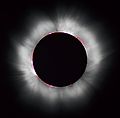Stellar atmosphere facts for kids

Photo taken in France during the 1999 solar eclipse
The stellar atmosphere is like the outer skin or air around a star. It's the part you see and study from far away. This outer layer sits right above the star's convection zone, which is where hot gases move around inside the star.
Contents
What Are the Layers of a Star's Atmosphere?
A star's atmosphere isn't just one big layer! It's made up of several different parts, each with its own special features. Let's explore them:
The Photosphere: Where Light Comes From
- The photosphere is the lowest and coolest layer of a star's atmosphere.
- It's the part of the star that we usually see and where most of its light comes from.
- For our own Sun, the photosphere is about 5,770 to 5,780 Kelvin (K) hot. That's super hot, but it's the coolest part of the atmosphere!
The Chromosphere: A Fiery Red Layer
- The chromosphere is the next layer, found just above the photosphere.
- It's much hotter than the photosphere, sometimes even 10 times hotter!
- During a total solar eclipse, you can sometimes see the chromosphere as a thin, reddish ring around the Sun.
The Transition Region: Getting Even Hotter
- After the chromosphere comes the transition region.
- This layer is where the temperature quickly jumps up even more.
- It's a very thin area where the gases are getting ready to become super-hot.
The Corona: The Star's Outer Glow
- The corona is the outermost part of a star's atmosphere.
- It's incredibly hot, reaching temperatures of about 1,000,000 K (one million degrees Kelvin)!
- For a long time, scientists thought only our Sun had a corona. But now we know that some very large stars, like giant stars and a few supergiant stars, also have this super-hot outer layer.
Images for kids
-
Photo taken in France during the 1999 solar eclipse
See also
 In Spanish: Atmósfera estelar para niños
In Spanish: Atmósfera estelar para niños

All content from Kiddle encyclopedia articles (including the article images and facts) can be freely used under Attribution-ShareAlike license, unless stated otherwise. Cite this article:
Stellar atmosphere Facts for Kids. Kiddle Encyclopedia.

